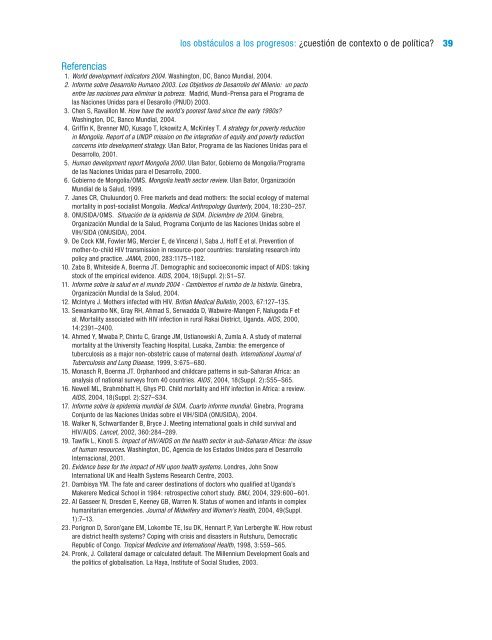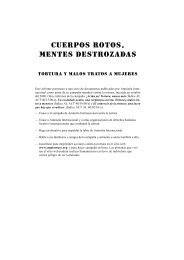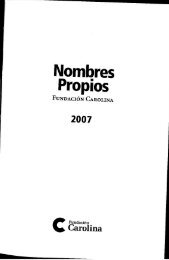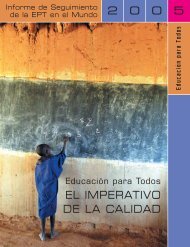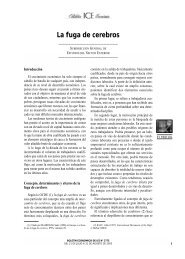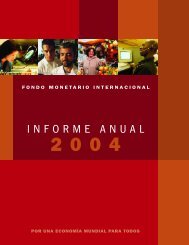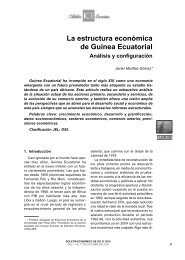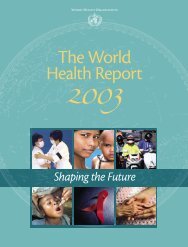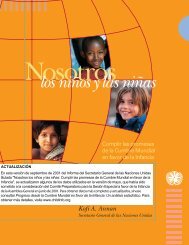38<strong>Informe</strong> <strong>sobre</strong> <strong>la</strong> <strong>salud</strong> <strong>en</strong> <strong>el</strong> <strong>mundo</strong> <strong>2005</strong>después de creados los distritos sanitarios, sólo disponían de esos medios 17 de los53 hospitales de distrito; es más, sólo cinco de esos 17 hospitales contaban con lostres médicos necesarios para garantizar <strong>la</strong> continuidad d<strong>el</strong> servicio durante todo e<strong>la</strong>ño (66).Ha sido decepcionante <strong>la</strong> l<strong>en</strong>titud con <strong>la</strong> que se han desplegado los distritos sanitarios:lleva tiempo transformar un distrito administrativo <strong>en</strong> un sistema de <strong>salud</strong>funcional (véase <strong>el</strong> recuadro 2.5). Sin embargo, allí donde han alcanzado <strong>el</strong> puntocrítico de su transformación <strong>en</strong> estructuras estables y viables, los distritos han ofrecidoresultados creíbles y pat<strong>en</strong>tes, a veces <strong>en</strong> circunstancias muy adversas, como<strong>en</strong> Guinea y <strong>la</strong> República Democrática d<strong>el</strong> Congo.Tomando <strong>en</strong> consideración todos los <strong>el</strong>em<strong>en</strong>tos, <strong>la</strong> experi<strong>en</strong>cia d<strong>el</strong> último dec<strong>en</strong>io indicaque, para los gobiernos, los distritos sanitarios sigu<strong>en</strong> si<strong>en</strong>do una forma racionalde desplegar <strong>la</strong> at<strong>en</strong>ción primaria por medio de redes de c<strong>en</strong>tros de <strong>salud</strong>, consultoriosde medicina de familia o estructuras desc<strong>en</strong>tralizadas equival<strong>en</strong>tes, respaldadas porhospitales de refer<strong>en</strong>cia. No exist<strong>en</strong> verdaderas alternativas que sirvan de vehículopara disp<strong>en</strong>sar a <strong>la</strong>s <strong>madre</strong>s, los recién nacidos y los niños una at<strong>en</strong>ción integrada eininterrumpida. El reto ahora es ampliar masivam<strong>en</strong>te su imp<strong>la</strong>ntación <strong>en</strong> un <strong>en</strong>tornoadverso <strong>en</strong> <strong>el</strong> que <strong>la</strong> exclusión se ve agravada por <strong>la</strong> comercialización galopante d<strong>el</strong>sector sanitario, incluidos los servicios de <strong>salud</strong> públicos o sin ánimo de lucro. Elsegundo reto es adaptar <strong>la</strong>s estrategias de disp<strong>en</strong>sación de at<strong>en</strong>ción de <strong>salud</strong> a <strong>la</strong>situación específica y los esquemas de exclusión de cada país. Al mismo tiempo, yano cabe experim<strong>en</strong>tar con proyectos de distritos sin t<strong>en</strong>er <strong>en</strong> cu<strong>en</strong>ta <strong>el</strong> contexto másamplio de <strong>la</strong>s limitaciones transversales que afectan a todo <strong>el</strong> sistema. Si no existe unverdadero compromiso de fortalecer los servicios de los distritos sanitarios, lo másprobable es que hab<strong>la</strong>r de <strong>la</strong> importancia prioritaria de <strong>la</strong>s <strong>madre</strong>s y los hijos se quede<strong>en</strong> mera pa<strong>la</strong>brería.Parte de <strong>la</strong> tarea p<strong>en</strong>di<strong>en</strong>te es política. La <strong>salud</strong> materna, neonatal e infantil no puedereducirse a un conjunto de programas destinados a una pob<strong>la</strong>ción determinada. Alcontrario, <strong>la</strong>s <strong>madre</strong>s y los niños deb<strong>en</strong> estar <strong>en</strong> situación de rec<strong>la</strong>mar una serie deprestaciones sociales por t<strong>en</strong>er derecho a <strong>el</strong><strong>la</strong>s. Ello implica un ajuste de <strong>la</strong>s políticassanitarias a niv<strong>el</strong> macroeconómico y <strong>la</strong> movilización de recursos <strong>en</strong> los p<strong>la</strong>nos nacionale internacional. Tres cuestiones exig<strong>en</strong> que se les preste at<strong>en</strong>ción: <strong>la</strong> financiación d<strong>el</strong>sector sanitario, <strong>la</strong> crisis de recursos humanos y <strong>la</strong> responsabilización de los sistemassanitarios y los proveedores de at<strong>en</strong>ción de <strong>salud</strong> ante sus cli<strong>en</strong>tes.Pero también sigue p<strong>en</strong>di<strong>en</strong>te <strong>la</strong> tarea de reori<strong>en</strong>tar <strong>el</strong> cont<strong>en</strong>ido de los programas.Durante demasiado tiempo se ha prestado at<strong>en</strong>ción al desarrollo de tecnologías y noa su imbricación <strong>en</strong> estrategias organizacionales viables que estructur<strong>en</strong> y garantic<strong>en</strong>una at<strong>en</strong>ción ininterrumpida. Dada <strong>la</strong> complejidad de <strong>la</strong> ampliación de los sistemas sanitariosbasados <strong>en</strong> distritos, surge <strong>la</strong> t<strong>en</strong>tación de regresar a los programas verticalesdesarrol<strong>la</strong>dos <strong>en</strong> torno a tecnologías de control de <strong>la</strong>s <strong>en</strong>fermedades. En <strong>el</strong> pasadoesta estrategia condujo a una gran fragm<strong>en</strong>tación, <strong>en</strong> detrim<strong>en</strong>to de <strong>la</strong> continuidad de<strong>la</strong> at<strong>en</strong>ción desde <strong>la</strong> gestación hasta <strong>el</strong> final de <strong>la</strong> infancia. En realidad, gran parte d<strong>el</strong>reto consiste <strong>en</strong> dar cabida tanto a <strong>la</strong>s cuestiones programáticas como a <strong>la</strong>s sistémicas,es decir, se trata de un problema más organizacional que técnico. Los capítulossigui<strong>en</strong>tes reubican <strong>la</strong>s estrategias técnicas capaces de mejorar <strong>la</strong> <strong>salud</strong> materna,neonatal e infantil d<strong>en</strong>tro de sistemas sanitarios que están ampliándose masivam<strong>en</strong>tey se <strong>en</strong>fr<strong>en</strong>tan a una demanda de asist<strong>en</strong>cia cada vez más notoria.
los obstáculos a los progresos: ¿cuestión de contexto o de política?39Refer<strong>en</strong>cias1. World dev<strong>el</strong>opm<strong>en</strong>t indicators 2004. Washington, DC, Banco Mundial, 2004.2. <strong>Informe</strong> <strong>sobre</strong> Desarrollo Humano 2003. Los Objetivos de Desarrollo d<strong>el</strong> Mil<strong>en</strong>io: un pacto<strong>en</strong>tre <strong>la</strong>s naciones para <strong>el</strong>iminar <strong>la</strong> pobreza. Madrid, Mundi-Pr<strong>en</strong>sa para <strong>el</strong> Programa de<strong>la</strong>s Naciones Unidas para <strong>el</strong> Desarollo (PNUD) 2003.3. Ch<strong>en</strong> S, Ravaillon M. How have the world’s poorest fared since the early 1980s?Washington, DC, Banco Mundial, 2004.4. Griffin K, Br<strong>en</strong>ner MD, Kusago T, Ickowitz A, McKinley T. A strategy for poverty reductionin Mongolia. Report of a UNDP mission on the integration of equity and poverty reductionconcerns into dev<strong>el</strong>opm<strong>en</strong>t strategy. U<strong>la</strong>n Bator, Programa de <strong>la</strong>s Naciones Unidas para <strong>el</strong>Desarrollo, 2001.5. Human dev<strong>el</strong>opm<strong>en</strong>t report Mongolia 2000. U<strong>la</strong>n Bator, Gobierno de Mongolia/Programade <strong>la</strong>s Naciones Unidas para <strong>el</strong> Desarrollo, 2000.6. Gobierno de Mongolia/OMS. Mongolia health sector review. U<strong>la</strong>n Bator, OrganizaciónMundial de <strong>la</strong> Salud, 1999.7. Janes CR, Chuluundorj O. Free markets and dead mothers: the social ecology of maternalmortality in post-socialist Mongolia. Medical Anthropology Quarterly, 2004, 18:230–257.8. ONUSIDA/OMS. Situación de <strong>la</strong> epidemia de SIDA. Diciembre de 2004. Ginebra,Organización Mundial de <strong>la</strong> Salud, Programa Conjunto de <strong>la</strong>s Naciones Unidas <strong>sobre</strong> <strong>el</strong>VIH/SIDA (ONUSIDA), 2004.9. De Cock KM, Fowler MG, Mercier E, de Vinc<strong>en</strong>zi I, Saba J, Hoff E et al. Prev<strong>en</strong>tion ofmother-to-child HIV transmission in resource-poor countries: trans<strong>la</strong>ting research intopolicy and practice. JAMA, 2000, 283:1175–1182.10. Zaba B, Whiteside A, Boerma JT. Demographic and socioeconomic impact of AIDS: takingstock of the empirical evid<strong>en</strong>ce. AIDS, 2004, 18(Suppl. 2):S1–S7.11. <strong>Informe</strong> <strong>sobre</strong> <strong>la</strong> <strong>salud</strong> <strong>en</strong> <strong>el</strong> <strong>mundo</strong> 2004 - Cambiemos <strong>el</strong> rumbo de <strong>la</strong> historia. Ginebra,Organización Mundial de <strong>la</strong> Salud, 2004.12. McIntyre J. Mothers infected with HIV. British Medical Bulletin, 2003, 67:127–135.13. Sewankambo NK, Gray RH, Ahmad S, Serwadda D, Wabwire-Mang<strong>en</strong> F, Nalugoda F etal. Mortality associated with HIV infection in rural Rakai District, Uganda. AIDS, 2000,14:2391–2400.14. Ahmed Y, Mwaba P, Chintu C, Grange JM, Ustianowski A, Zum<strong>la</strong> A. A study of maternalmortality at the University Teaching Hospital, Lusaka, Zambia: the emerg<strong>en</strong>ce oftuberculosis as a major non-obstetric cause of maternal death. International Journal ofTuberculosis and Lung Disease, 1999, 3:675–680.15. Monasch R, Boerma JT. Orphanhood and childcare patterns in sub-Saharan Africa: ananalysis of national surveys from 40 countries. AIDS, 2004, 18(Suppl. 2):S55–S65.16. New<strong>el</strong>l ML, Brahmbhatt H, Ghys PD. Child mortality and HIV infection in Africa: a review.AIDS, 2004, 18(Suppl. 2):S27–S34.17. <strong>Informe</strong> <strong>sobre</strong> <strong>la</strong> epidemia mundial de SIDA. Cuarto informe mundial. Ginebra, ProgramaConjunto de <strong>la</strong>s Naciones Unidas <strong>sobre</strong> <strong>el</strong> VIH/SIDA (ONUSIDA), 2004.18. Walker N, Schwart<strong>la</strong>nder B, Bryce J. Meeting international goals in child survival andHIV/AIDS. Lancet, 2002, 360:284–289.19. Tawfik L, Kinoti S. Impact of HIV/AIDS on the health sector in sub-Saharan Africa: the issueof human resources. Washington, DC, Ag<strong>en</strong>cia de los Estados Unidos para <strong>el</strong> DesarrolloInternacional, 2001.20. Evid<strong>en</strong>ce base for the impact of HIV upon health systems. Londres, John SnowInternational UK and Health Systems Research C<strong>en</strong>tre, 2003.21. Dambisya YM. The fate and career destinations of doctors who qualified at Uganda’sMakerere Medical School in 1984: retrospective cohort study. BMJ, 2004, 329:600–601.22. Al Gasseer N, Dresd<strong>en</strong> E, Ke<strong>en</strong>ey GB, Warr<strong>en</strong> N. Status of wom<strong>en</strong> and infants in complexhumanitarian emerg<strong>en</strong>cies. Journal of Midwifery and Wom<strong>en</strong>’s Health, 2004, 49(Suppl.1):7–13.23. Porignon D, Soron’gane EM, Lokombe TE, Isu DK, H<strong>en</strong>nart P, Van Lerberghe W. How robustare district health systems? Coping with crisis and disasters in Rutshuru, DemocraticRepublic of Congo. Tropical Medicine and International Health, 1998, 3:559–565.24. Pronk, J. Col<strong>la</strong>teral damage or calcu<strong>la</strong>ted default. The Mill<strong>en</strong>nium Dev<strong>el</strong>opm<strong>en</strong>t Goals andthe politics of globalisation. La Haya, Institute of Social Studies, 2003.


